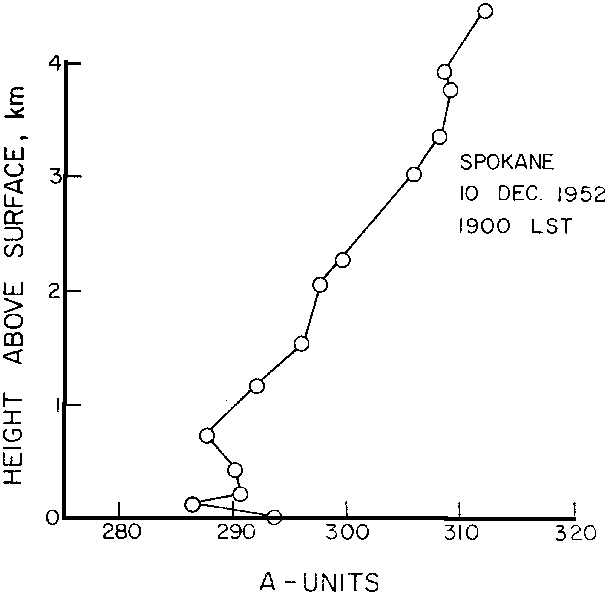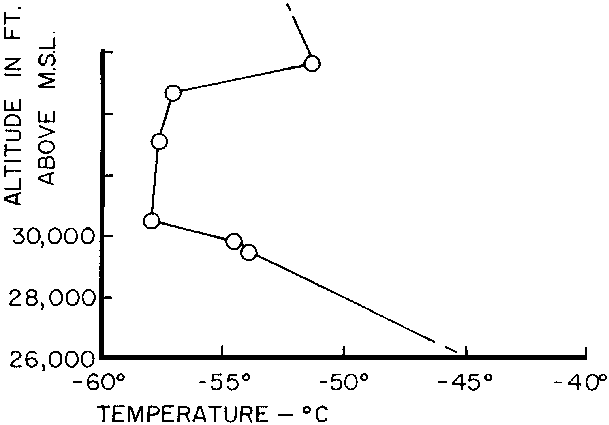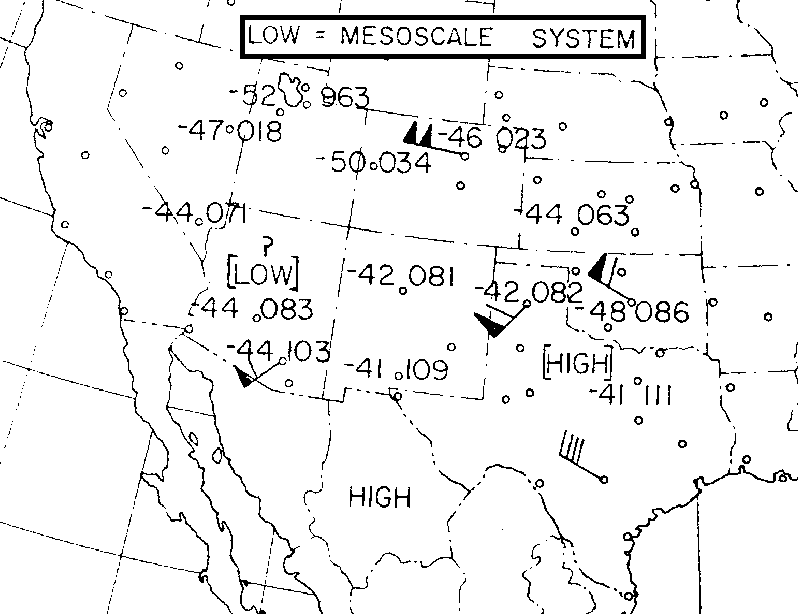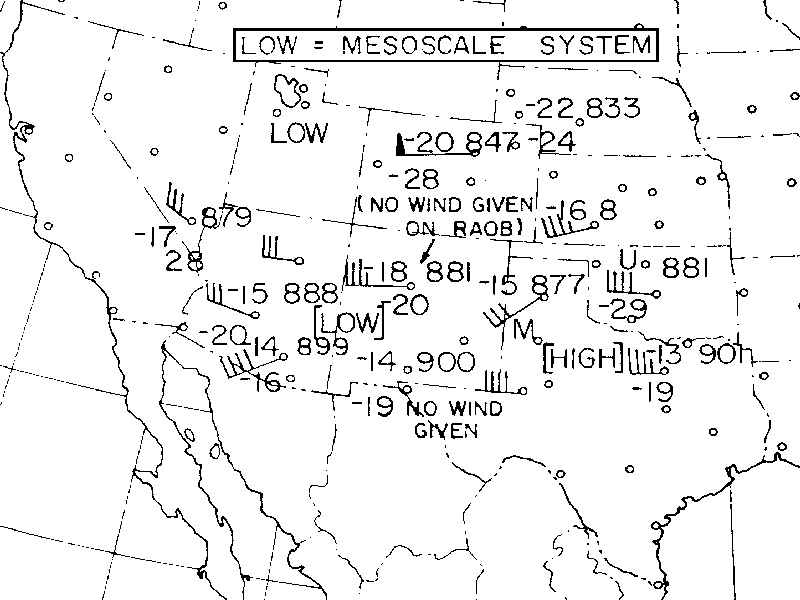Au-dessus du Labrador, . Météo : (à 19 000 pieds) clair, avec une couche brisée de stratocumulus en-dessous, visibilité excellente. Aucun contact radar ne fut fait durant cet incident. Une synthèse du récit de 1ʳᵉ main de son expérience par le pilote :
J'étais aux commandes d'un Boeing Strato cruiser de la BOAC en route de New York pour Londres via Goose Bay Labrador (escale de carburant). Peu après être passé au-dessus de Seven Islands à 19 000 pieds, Véritable Vitesse de l'Air 230 nœuds, mon copilote et moi-même prirent conscience de quelque chose se déplaçant along off our port beam à une altitude inférieure à une distance de peut-être 5 miles, à l'intérieur et à l'extérieur d'une couche brisée de nuages strato cumulus. Alors que nous regardions, ces objets montèrent au-dessus du nuage et nous pouvions maintenant en voir clairement 1 grand et 6 petits. Alors que nous volions vers Goose Bay le grand objet commença à changer de forme et le plus petit à se déplacer relativement au plus grand...
Nous avons informé Goose Bay que nous avions quelque chose de bizarre en vue et ils s'arrangèrent pour envoyer un chasseur (F-94 ?) sur nous. Plus tard, je changeais de fréquence radio pour contacter ce chasseur ; le pilote me dit qu'il m'avait en vue sur le radar se rapprochant face à moi à 20 miles. À ce moment les petits objets semblaient entrer dans le grand, puis le gros se rétrécit. Je donnais une description de cela au chasseur et a bearing des objets par rapport à moi. Je dus alors revenir sur la fréquence de Goose pour autorisation de descente. Je ne sais pas si le chasseur a vu quelque chose, car il n'avait pas atterri lorsque j'ai quitté Goose pour Londres.
La description de l'ovni dans ce cas, un objet opaque, sombre et "comme de la gelée", changeant constamment de forme, suggère une cause optique. Très peu de données météorologiques sont disponibles pour cette partie du monde à la date en question, de sorte que la présence de mécanismes significatifs de propagation optique ne peut être confirmée ni exclue. Néanmoins, certains faits dans le cas suggèrent fortement un phénomène de mirage optique :
- L'ovni était toujours situé dans les quelques degrés d'un plan horizontal contenant l'appareil, satisfaisant ainsi la nécessité d'un angle réduit ;
- L'appareil volait à une altitude stable de 19000 pieds pendant les 85 miles nautiques sur lesquels l'ovni apparut "accompagner" l'appareil, et l'avion maintenait donc une relation constante avec toute couche atmosphérique à une altitude fixe ;
- L'ovni sombre fut vu devant un fond de ciel brillant dans 5° à 20 ° du soleil couchant ; des images prartiquement identiques, montrant un comportement "semblable à une méduse" pourrait être courramment observé partout où des mirages sont observés avec un fort contraste lumineux présent. La réflexion de la Lune sur une eau doucement ondulante présente un comportement assez semblable.
Il y a une forte suggestion que l'ovni dans ce cas ait été un mirage : une réflexion du terrain sombre en-dessous vu against le ciel brillant, "argenté" à gauche du soleil couchant. La couche réfléchissante serait une inversion de température aigüe et fine située à une altitude juste au-dessus de celle de l'appareil naviguant. La plupart des faits dans cet incident peuvent être expliqués par cette hypothèse. La nature sombre et opaque de l'image vient du contraste de luminosité et du phénomène de "réflexion totale". L'arrangement du grand objet et des petits en une ligne fine juste au-dessus de la trajectoire de vol de l'appareil, ainsi que la manière de disparaître, sont proportionné avec un mirage. À mesure que la couche de production du mirage s'affaiblit (avec la distance) ou que l'angle de visualisation décroît (l'appareil entamait-il sa descente à ce moment ?), le mirage semble diminuer jusqu'à un certain point et dispparaître. Ce type de mirage est qualifié de mirage supérieur et a souvent été signalé au-dessus de l'océan (voir section 6, chapitre 4).
La principale difficulté avec cette explication, outre le fait d'avoir à faire l'hypothèse de l'existence de la couche produisant le mirage, est la façon d'expliquer l'anisotropie du mirage. Une anisotropie de cette sorte, c.-à-d., un mirage limité à certains azimuts de visualisation, est courant dans des mirages terrestres lorsqu'ils sont vus d'un lieu unique. Mais une couche de mirage à travers laquelle une image réfléchie pourrait être vue seulement dans une direction constante principale (plus quelques petites images "satellites") sur une distance de 85 miles nautiques est assez inhabituelle.
Reste ici la mince possibilité que l'appareil lui-même ait produit la couche de mirage par intensification (par la compression induite par l'onde de choc du passage de l'appareil dans l'air) d'une couche barely subcritical, c.-à-d., une dans laquelle le gradient de température est juste un petit peu inférieur à la valeur requise pour produire un mirage. Cette hypothèse satisferait la nécessité directionnelle de l'observation, mais l'arrangement résultant d'hypothèses est trop spéculatif pour former une solution acceptable à l'incident.
Cette observation inhabituelle devrait par conséquent être affectée à la catégorie d'un phénomène naturel presque certain, qui est si rare qu'il n'a apparemment jamais été signalé auparavant ni depuis.

304-B
Odessa (Washington), 10 décembre 1952, .
Météo : clair au-dessus du plafond nuageux à 3000 pieds ; appareil à 26 000-27 000 pieds. 2 pilotes dans un appareil F-94 observèrent un grand objet rond et blanc, plus
grand que tout type d'avion connu.
Une lumière dim reddish-white seemed to come from 2 fenêtres
. It
appeared to be able to "reverse direction almost instantly
," and did a chandelle in front of the aircraft.
After this the object appeared to rush toward the aircraft head-on and then would "suddenly stop and be pulling
off
." The pilot banked away to avoid an apparently imminent collision, and lost visual contact. Fifteen minutes
later the aircraft radar picked up something which the crew assumed was the UFO, although there is no evidence that it
was. The object was reported to be moving generally from west to east at 75 noeuds. It was never sighted.
This sighting has been described as a mirage of Venus, although the reported 75 noeuds speed and 270° direction of motion is in contradiction to this hypothesis. The general description of the object as well as the reported motion is suggestive of a weather balloon. However, the peculiar reversals of direction, although they could have been illusory, and particularly the loss of visual contact are at odds with the balloon hypothesis.
The radiosonde profile for Spokane, , is shown in Fig. 9 and is inconclusive. The tropopause, where the sharpest temperature inversions are likely, is at about 30 500 pieds above sea level, too high to have produced a mirage visible à 26 000-27 000 pieds.
The closeness of the timing between the radiosonde release at 19:00
LST and the sighting at suggests that the F-94 crew may have seen a lighted pibal balloon.
The description given, including the two dimly-lit "windows
," is typical of the description of a pibal balloon
by those not familiar with weather instrumentation. Such a balloon would rise to at least 17,000 ft. in 15 min., and
the reported motion, 270° at 75 knots, is in excellent agreement with the upper winds at the highest level plotted for
the Spokane profile: 280° at 66 noeuds à 18 000 pieds.

19-X. [361-B]. Kirtland AFB, Albuquerque, N.M., 4 Nov. 1957, . Weather: scattered clouds with high overcast, visibility good, thunder-storms and rain showers in vicinity, light rain over airfield. Observers in the CAA (now FAA) control tower saw an unidentified dark object with a white light underneath, about the "shape of an automobile on end," that crossed the field at about 1500 pieds and circled as if to come in for a landing on the E-W runway. This unidentified object appeared to reverse direction at low altitude, while out of sight of the observers behind some buildings, and climbed suddenly to about 200-300 pieds, heading away from the field on a 120° course. Then it went into a steep climb and disappeared into the overcast.
The Air Force view is that this UFO was a small, powerful private aircraft, flying without flight plan, that became confused and attempted a landing at the wrong airport. The pilot apparently realized his error when he saw a brightly-lit restricted area, which was at the point where the object reversed direction. The radar blip was described by the operator as a "perfectly normal aircraft return," and the radar track showed no characteristics that would have been beyond the capabilities of the more powerful private aircraft available at the time. There seems to be no reason to doubt the accuracy of this analysis.
1482-N
À environ 15 miles à l'est d'Utica (New York), juin 1955, . Météo : temps couvert à
4000 pieds, visibilité bonne en-dessous. Rapporté par le co-pilote d'un DC-3 de Mohawk Airlines. Ils volaient à 3000 pieds et 160
nœuds, lorsqu'il remarqua un objet passant à peu près à 500 pieds au-dessus à angle d'environ 70° (20° de la
verticale). Il se déplaçait à grande vitesse
. Le corps était gris clair, presque rond, avec une ligne
centrale... Sous la ligne se trouvaient plusieurs (au moins 4) fenêtres qui émettaient une lumière bleue-verte. Il
ne tournait pas, mais allait tout droit.
Le pilote vit aussi cet ovni ; ils le regardèrent pendant plusieurs miles. Alors que la
distance entre le DC-3 et l'ovni augmentait, les lumières semblèrent changer légèrement de couleur du verdâtre au
bleuâtre ou vice versa. Quelques mn après qu'il soit parti hors de vue, 2 autres appareils (un, un DC-3
Colonial, l'autre je n'ai pas chopé le numéro) signalèrent l'avoir vu et demandèrent si quelqu'un d'autre l'avait
vu. La tour de contrôle d'Albany signala aussi qu'ils avaient vu un objet passer sur
[la voie
aérienne]
Victor-2
. Alors que nous approchions Albany, nous entendîmes que le radar de Boston avait
aussi repéré un objet le long de Victor-2, dépasser Boston et toujours continuer vers l'est.
Le pilote et le co-pilote calculèrent la "vitesse" de l'ovni entre 4500 et 4800 miles/h d'après les heures de contact près de Utica et à Boston. Il existe un certain nombre d'incohérences dans ce rapport, à côté de la plus évidente : l'absence d'un bang sonique dévastateur, qui aurait dû être généré par un objet ellipsoidal de 150 pieds voyageant à Mach 6 ou plus en vol horizontal à 3500 pieds. Il ne semble pas probable que le signalement de la GCA de Boston soit une coïncidence et ait impliqué un objet différent.
Le résidu est un rapport particulièrement intriguant, qui doit certainement être classé comme un non-identifié nécessitant une étude plus poussée, qu'il mérite certainement. Des déclarations de certains des autres témoins aideraient à analyser l'événement, et devraient se révéler utiles même 13 ans après les faits. Il semble que cette observation défie une explication par des moyens conventionnels.
10-X [371-B]
Continental Divide, N. M., 26 janvier 1953, . Météo : couverture nuageuse légère et élevée, nuages bas épars, très bonne visibilité. Un aviateur basé au 769ème escadron AC&W at Continental Divide (elevation 7,500 ft.) observed a "bright reddish-white object" about 10 miles à l'ouest du radar site and approximately 2,000 ft. above the terrain. The radar subsequently painted a strong, steady return at 9 mi. range and about 2500-7500 pieds au-dessus de lasurface. This object passed behind a nearby hill and reappeared, heading north at about 10-15 miles/h. Radar track confirmed this. The object then moved to the west at 12-15 miles/h to a point 18 mi. west of the radar site. It then turned north for about 10 miles, and subsequently turned back on a heading of 128° inbound to the station. Radar and visual contact was lost near the area where the object was first detected. Before disappearing, the object seemed to shrink in size and fade in color to a dull red.

There seems to be little doubt in this case that the visual and radar contacts were in fact of the same object. The obvious interpretation is that the object seen and tracked on radar was a weather balloon, a lighted pibal used for obtaining data on upper winds. This explanation was considered and rejected by Air Force investigators for 2 reasons:
- The sighting occurred 1 hr. 15 mm. after the scheduled release of the Winslow, Ariz. pibal, the only one that seemed likely to have showed up in the sighting area, and the balloon ought to have burst by then, since they generally burst at 30 000 pieds, une altitude que the Winslow pibal should have reached 25 mn after launch;
-
The reported direction of movement was, at least part of the time, directly opposite to the reported upper winds as
derived from the Albuquerque radiosonde flight. These winds were reported from the Ouest
entre 10 000 et 30 000 pieds
.
Actually, neither of these two reasons is sufficient to discount the balloon theory. In the first place, weather balloons are often released later than the scheduled time, and this possibility was apparently not checked. In the second place, pibal balloons are often known to leak and consequently to rise at a much slower rate than normal. Often they have so little buoyancy that they may be caught in local updrafts or downdrafts. These leaking balloons are usually carried away by the horizontal wind flow at such a rate that they are lost from sight of the observing station before they reach burst altitude. The pibal data from Winslow, Ariz. for 0300 GMT 27 January 1953, (2000 LST 26 January) is listed as "missing" above the 500 mb level (about 19,000 ft. m.s.l.), which is a strong indication that the balloon may have been leaking. It is therefore entirely conceivable that the Winslow pibal balloon could have been in the vicinity of Gallup, N. M. (west of the radar site) at 2115 LST on the night in question.
The problem of the observed direction of movement cannot be completely resolved, because it depends largely on an analysis of mesoscale winds in the lower atmosphere, that is, on a scale smaller than ordinarily analyzed n synoptic weather maps. The synoptic maps for 2000 LST 26 January 1953, for the 700 mb (about 10 000 pieds), 500 mb (environ 19 000 pieds), and 300 mb (about 27 000 pieds) levels are shown in Figs. 10 et 11.

Although the general windflow in the Arizona-New Mexico area for at least the 700 and 500 mb maps is from the west, there are indications of a secondary mesoscale circulation somewhere in the vicinity of the Arizona-New Mexico border, which is embedded in the general trough overlying the southwestern states. Especially significant are the winds at the 700 and 500 mb levels at Tucson and at Phoenix, mainly at the 500 mb level, which show evidence of a mesoscale cyclonic circulation in the area.
In view of the general meteorological situation at the time, a quite likely explanation for the Continental Divide sighting is as follows: The Winslow pibal balloon, which was leaking, was carried away to the east, probably sinking slowly as it went, and was lost from view of the Winslow weather station. Upon reaching the general vicinity of Gallup, N. M. the leaking balloon was probably caught up in a local cyclonic vortex and updraft, which, being instigated by the mesoscale cyclonic flow in the region may have formed on the windward side of the range of low mountains forming the Divide in that area. This would have caused the balloon to be carried toward the north, slowly rising, as first observed. This would be followed in sequence by a turn to the west, and ultimately, upon reaching a somewhat higher level, a turn toward the southeast again as the balloon became caught in the more general flow from the west and northwest prevailing at middle levels in the atmosphere.
This hypothesis fits the details of the observations rather well, and considering the lack of additional information or data pertaining to this incident, the UFO should probably be tentatively identified as a weather balloon.
321-B
Niagara Falls, N. Y., 25 July 1957, . Météo : temps clair, visibilité excellente. Observers saw
a "circular brilliant white object with pale green smaller lights around its perimeter
." Object appeared to
move slowly at nearly constant altitude, and then went into a "fast, steep climb
," disappearing in about 5-8
min. The object was tracked on a CPS-6B radar for about 3 min. moving from SW to NE, in agreement with prevailing
winds in the area.
The rate of climb could not have been very great, or the object would not have remained in sight for 5 à 8
mn.
The official AF view is that the object was a lighted balloon, and in the absence of other data or a more complete
file on the case, there seems to be no more likely explanation.